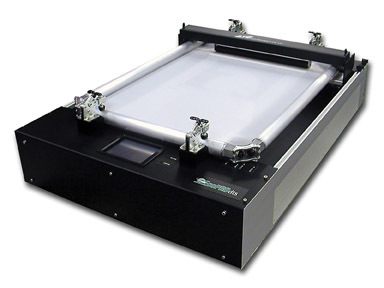Computer-to-screen systems (CTS) give graphics and garment screen printers an edge in the prepress department. These units streamline the stencilmaking workflow and remove some of the variables that lurk within. But perhaps the greatest benefit computer-to-screen systems offer is the opportunity to eliminate film generation—a step in the process that can consume lots of time and money.
Many of the CTS devices on the market are designed for large-format, high-volume graphics. Only in the past few years has the industry seen the introduction of more compact formats for garment screen printing and other applications. CTS systems are now more accessible to screen printers in a wider array of markets, but the technology, given the cost of implementation, has remained out of reach for those who focus on shorter runs or are in the early stages of building a screen-printing business.
OYO Instruments describes its EcoPROdts Imaging System as a CTS solution designed for entry-level printers and for those who dedicate a majority of their press time to small- and medium-volume jobs. The company says EcoPROdts also has a place in bigger shops that want to dedicate a stencilmaking system to product prototyping, sampling, and job sizes that may otherwise not be profitable.
EcoPROdts supports frames up to 23 x 31 x 1.5 in. (584 x 787 x 38 mm), a maximum imaging area of 14 x 25 in. (356 x 635 mm), imaging resolutions up to 600 dpi (halftones up to 85 lines/in.), and imaging speeds up to 0.17 in./sec (4 mm/sec). It uses a proprietary thermal imaging system, a printhead manufactured by OYO, and precoated mesh to produce stencils. The ceramic-based printhead, which spans the entire width of the screen, travels out and back (not side to side as would a conventional inkjet system) and uses heated nibs to essentially shrink the thermal-reactive, polyester-like mesh coating onto itself, thereby creating the image area in the stencil. The thermal imaging process is completed in a single pass, and OYO says the system can make a stencil on a full-size screen in 1-2 min.
According to OYO, the precoated mesh eliminates coating, exposure, drying, and washout from the stencilmaking process. OYO supplies precoated mesh in rolls. Available mesh counts include 80, 100, 120, 200, and 305 threads/in. The mesh is coated nearly edge to edge at 1.8 microns on one side. OYO may make other coating thicknesses available in to accommodate special-effects printing and other applications.
Users may tension the precoated mesh to 25-30 N/cm and mount it to roller frames or stretch-and-glue frames (OYO recommends the use of roller frames). The screen is then locked into EcoPROdts’s three-point registration system. A Harlequin RIP drives the EcoPROdts. Operators can simply drag, drop, and print files or use advanced RIP functions to queue and preview jobs, change image position, calibrate for dot gain, and more. The printer also features a touch-panel controller.
OYO says stencils produced on the EcoPROdts support up to 500 impressions on automatic presses and up to 2000 impressions on manual equipment. That recommended duty cycle, and the fact that the mesh is disposable, practically removes retensioning on press and post-production labor, such as cleaning and reclaiming, from the shop’s workflow and eliminates expenditures on chemicals.
EcoPROdts is compatible with Mac OS X and Windows 2000 and XP computers and connects via USB 2.0 and 10/100 Mbps Ethernet. The Harlequin RIP supports PostScript, TIFF, PDF, EPS, and JPEG files. EcoPROdts consumes 25 w of power when idling and 650 w in print mode. The unit’s dimensions are 28 x 40 x 12.5 in. (508 x 1016 x 318 mm), and it weighs 65 lb (29 kg). For more information, contact OYO Instruments, 7007 Pinemont Dr., Houston, TX 77040, 713-937-5800, 800-747-7651, fax: 713-849-3022, Web: www.oyo.com.

 Case Studies2 months ago
Case Studies2 months ago
 Art, Ad, or Alchemy2 months ago
Art, Ad, or Alchemy2 months ago
 Andy MacDougall2 months ago
Andy MacDougall2 months ago
 Columns3 weeks ago
Columns3 weeks ago
 Editor's Note3 weeks ago
Editor's Note3 weeks ago
 Marshall Atkinson3 weeks ago
Marshall Atkinson3 weeks ago
 Thomas Trimingham2 months ago
Thomas Trimingham2 months ago
 News & Trends2 months ago
News & Trends2 months ago






